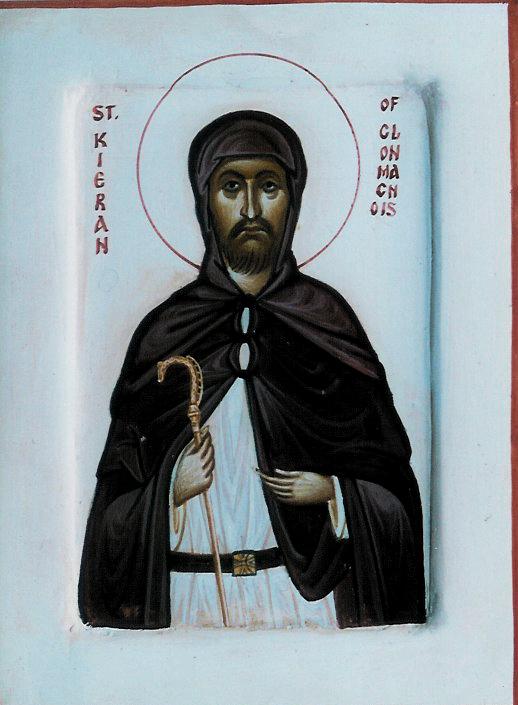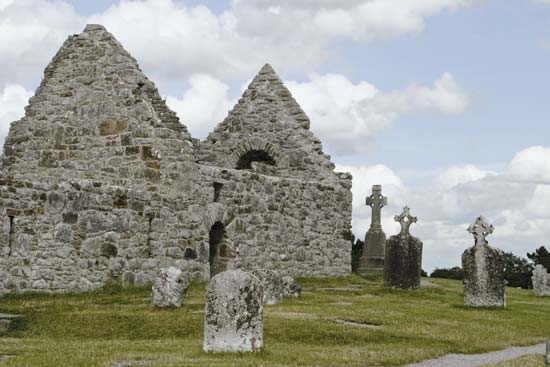(† 544)
Source: http://www.stkieranchurch.org/Biography_of_St_Kieran.html

| Orthodox Outlet for Dogmatic Enquiries | Biographies |
|---|
|
Saint Kieran (Ciaran) founder of
Clonmacnoise Monastery, Ireland († 544) Source: http://www.stkieranchurch.org/Biography_of_St_Kieran.html |
 |
A first approach to the indigenous Orthodox Saints and Martyrs of the Ancient Church who lived and who propagated the Faith in the British Isles and Ireland during the first millennium of Christianity and prior to the Great Schism is being attempted in our website in our desire to inform our readers, who may not be aware of the history, the labours or the martyrdom of this host of Orthodox Saints of the original One, Holy, Catholic and Apostolic Church of our Lord.
"The Church in The British Isles will only begin to grow when she begins to venerate her own Saints" (Saint Arsenios of Paros †1877)
|
WWWWWWWWWWWWWWWW
Situated on the Shannon, about half way between Athlone and Banagher, King's County, Ireland, and the most remarkable of the ancient schools of Erin. Its founder was St. Ciaran, surnamed Mac an Tsair, or "Son of the Carpenter", and thus distinguished from his namesake, the patron saint of Ossory. He chose this rather uninviting region because he thought it a more suitable dwelling-place for disciples of the Cross than the luxuriant plains not far away. Ciaran was born at Fuerty, County Roscommon, in 512, and in his early years was committed to the care of a deacon named Justus, who had baptized him, and from whose hands he passed to the school of St. Finnian at Clonard.
Here he met all those saintly youths who with himself were afterwards known as the "Twelve Apostles of Erin", and he quickly won their esteem. When Finnian had to absent himself from the monastery, it was to the youthful Ciaran that he deputed his authority to teach and "give out the prayers", and when Ciaran announced his intended departure, Finnian would fain resign to him his cathair, or chair, and keep him in Clonard. But Ciaran felt himself unripe for such responsibility, and he knew, moreover, he had work to do elsewhere.
After leaving Clonard, Ciaran, like most of the contemporary Irish saints, went to Aran to commune with holy Enda. One night the two saints beheld the same vision, "of a great fruitful tree, beside a stream, in the middle of Ireland, and it protected the island of Ireland, and its fruit went forth over the sea that surrounded the island, and the birds of the world came to carry off somewhat of its fruit". And when Ciaran spoke of the vision to Enda, the latter said to him: "The great tree which thou beholdest is thou thyself, for thou art great in the eyes of God and men, and all Ireland will be full of thy honour. This island will be protected under the shadow of thy favour, and multitudes will be satisfied with the grace of thy fasting and prayer. Go then, with God's word, to a bank of a stream, and there found a church."
Ciaran obeyed. On reaching the mainland he first paid a visit to St. Senan of Scattery and then proceeded towards the "middle of Ireland", founding on his way two monasteries, in one of which, on Inis Ainghin, he spent over three years.
Going farther south he came to a lonely waste by the Shannon, and seeking out a beautiful grassy ridge, called Ard Tiprait, or the "Height of the Spring," he said to his companions: "Here then we will stay, for many souls will go to heaven hence, and there will be a visit from God and from men forever on this place".
Thus, on 23 January, 544, Ciaran laid the foundation of his monastic school of Clonmacnoise, and on 9 May following he witnessed its completion. Diarmait, son of Cerball, afterwards High King of Ireland, aided and encouraged the saint in every way,promising him large grants of land as an endowment. Ciaran's government of his monastery was of short duration; he was seized by a plague which had already decimated the saints of Ireland, and died 9 September, 544.
It is remarkable that a young saint dying before he was thirty-three, should have been the founder of a school whose fame was to endure for centuries. But Ciaran was a man of prayer and fasting and labour, trained in all the science and discipline of the saints, humble and full of faith, and so was a worthy instrument in the hands of Providence for the carrying out of a high design. St. Cummian of Clonfert calls him one of the Patres Priores of the Irish Church, and Alcuin, the most illustrious alumnus of Clonmacnoise, proclaims him the Gloria Gentis Scotorum. His festival is kept on 9 September, and his shrine is visited by many pilgrims.
Ciaran left but little mark upon the literary annals of the famous school he founded. But in the character which he gave it of a seminary for a whole nation, and not for a particular tribe or district, is to be found the secret of its success. The masters were chosen simply for their learning and zeal; the abbots were elected almost in rotation from the different provinces; and the pupils thronged thither from all parts of Ireland, as well as from the remote quarters of France and England.
From the beginning it enjoyed the confidence of the Irish bishops and the favour of kings and princes who were happy to be buried in its shadow. In its sacred clay sleep Diarmait the High King, and his rival Guaire, King of Connaught; Turlough O'Conor, and his hapless son, Roderick, the last King of Ireland, and many other royal benefactors, who believed that the prayers of Ciaran would bring to heaven all those who were buried there.
But Clonmacnoise was not without its vicissitudes. Towards the close of the seventh century a plague carried off a large number of its students and professors; and in the eighth century the monastery was burned three times, probably by accident, for the buildings were mainly of wood. During the ninth and tenth centuries it was harassed not only by the Danes, but also, and perhaps mainly, by some of the Irish chieftains. One of these, Felim MacCriffon, sacked the monastery three times, on the last occasion slaughtering the monks, we are told, like sheep. Even the monks themselves were infected by the bellicose spirit of the times, which manifested itself not merely in defensive, but some times even in offensive warfare. These were evil days for Clonmacnoise, but with the blessing of Ciaran, and under the "shadow of his favour", it rose superior to its trials, and all the while was the Alma Mater of saints and sages.
Under date 794, is recorded the death of Colgu the Wise, poet, theologian, and historian, who is said to have been the teacher of Alcuin at Clonmacnoise (see Coelchu). Another alumnus of vast erudition, whose gravestone may still be seen there, was Suibhne, son of Maclume, who died in 891. He is described as the "wisest and greatest Doctor of the Scots", and the annals of Ulster call him a "most excellent scribe". Tighernach, the most accurate and most ancient prose chronicler of the northern nations, belongs to Clonmacnoise, and probably also Dicuil (q.v), the world-famed geographer. In this school were composed the "Chronicon Scotorum", a valuable chronicle of Irish affairs from the earliest times to 1135, and the "Leabhar na h-Uidhre", which, excepting the "Book of Armagh", is the oldest Irish historical transcript now in existence. In the twelfth century Clonmacnoise was a great school of Celtic art, architecture, sculpture, and metal work. To this period and to this school we owe the stone crosses of Tuam and Cong, the processional cross of Cong (below), and perhaps the Tara Brooch and the Chalice of Ardagh. The ruined towers and crosses and temples are still to be seen; but there is no trace of the little church of Ciaran (below) which was the nucleus of Clonmacnoise.

Saint Ciaran
of Clonmacnoise’s church, County Offaly,
Ire.
|
Article published in English on: 2-9-2009.
Last update: 20-3-2011.